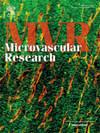Evaluation of neovascularization in murine osteoarthritis using micro-computed tomography
IF 2.7
4区 医学
Q2 PERIPHERAL VASCULAR DISEASE
引用次数: 0
Abstract
Purpose
The study aimed to examine neovascularization in murine osteoarthritis (OA) using micro-computed tomography (μCT).
Materials and methods
OA was induced in eighteen mice through intra-articular collagenase injection, designating the left hindlimbs as OA models and the right hindlimbs as controls. Mice were monitored for 4, 8, or 12 weeks post-induction. Hindlimbs underwent overnight tissue fixation and were then subjected to μCT scanning. Quantification of unnamed arterial branches spanned from the femoral artery's terminal branching point to 2.5 mm below the tibial plateau.
Results
Baseline characteristics did not differ significantly between control and OA-induced groups (p > 0.05). Collagenase-treated limbs showed a significantly higher number of unnamed arterial branches compared to controls (11.6 vs. 7.5, p < 0.001), reflecting increased neovascularization. This elevation persisted across all post-induction time points, with no significant time-dependent trend (p = 0.09) or interaction between time and treatment group (p = 0.17). Spatial analysis revealed that neovessels were predominantly localized to peri-meniscal (61 %) and subchondral (29 %) regions.
Conclusion
Collagenase-induced OA in mice results in sustained and spatially patterned neovascularization, detectable using non-contrast μCT. These findings underscore the utility of μCT for tracking vascular remodeling in OA and highlight potential anatomical targets for angiogenesis-modulating therapies.
用微计算机断层扫描评价小鼠骨关节炎的新生血管。
目的:利用微计算机断层扫描(μCT)观察小鼠骨关节炎(OA)新生血管的形成情况。材料与方法:18只小鼠关节内注射胶原酶诱导OA,左后肢为OA模型,右后肢为对照组。小鼠在诱导后4、8或12 周进行监测。后肢组织固定过夜后进行μCT扫描。从股动脉末端分支点到胫骨平台下2.5 mm的未命名动脉分支的定量。结果:对照组和oa诱导组的基线特征无显著差异(p > 0.05)。与对照组相比,胶原酶治疗的肢体显示出更多的未命名动脉分支(11.6比7.5,p )。结论:通过非对比μCT检测,胶原酶诱导的小鼠OA导致持续和空间模式的新血管形成。这些发现强调了μCT在追踪OA血管重构方面的效用,并强调了血管生成调节疗法的潜在解剖学靶点。
本文章由计算机程序翻译,如有差异,请以英文原文为准。
求助全文
约1分钟内获得全文
求助全文
来源期刊

Microvascular research
医学-外周血管病
CiteScore
6.00
自引率
3.20%
发文量
158
审稿时长
43 days
期刊介绍:
Microvascular Research is dedicated to the dissemination of fundamental information related to the microvascular field. Full-length articles presenting the results of original research and brief communications are featured.
Research Areas include:
• Angiogenesis
• Biochemistry
• Bioengineering
• Biomathematics
• Biophysics
• Cancer
• Circulatory homeostasis
• Comparative physiology
• Drug delivery
• Neuropharmacology
• Microvascular pathology
• Rheology
• Tissue Engineering.
 求助内容:
求助内容: 应助结果提醒方式:
应助结果提醒方式:


